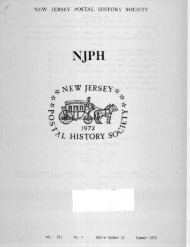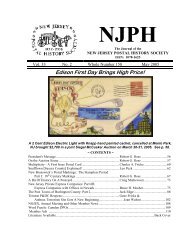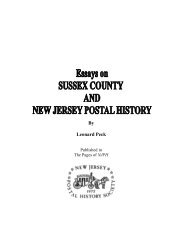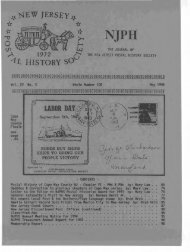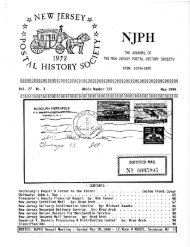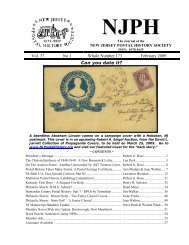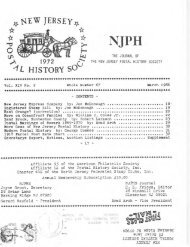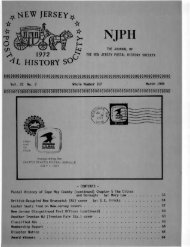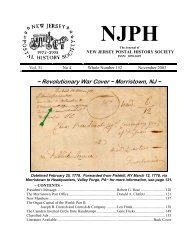99 - New Jersey Postal History Society
99 - New Jersey Postal History Society
99 - New Jersey Postal History Society
You also want an ePaper? Increase the reach of your titles
YUMPU automatically turns print PDFs into web optimized ePapers that Google loves.
Valuing <strong>Postal</strong> <strong>History</strong>By Edward HinesOne of the great mysteries forcollectors and dealers alike is determiningthe value of postal history.You will notice that the titleof this article is "Valuing <strong>Postal</strong><strong>History</strong>" and not "Pricing <strong>Postal</strong><strong>History</strong>." As you will see, there isa difference. This is such a vasttopic that I will need several articlesto fully cover the subject.Even then, I am sure that questionswill arise.DEFINE YOUR GOALSDo you exhibit? Are you goingfor the gold? In this case you canget into uncomfortable situationswhen you need a particular coverto fill a hole in your exhibit. Anexhibitor recently told me that hehas two categories in his buying, aneed and a want. The need is whathe believes to be a prime priority.The want is what he would like tohave, but which is not necessary.If two or more collectors seeone item as a need, problems arise.At an auction, the price will rise,at times to an unrealistic level.Through a retail dealer, the collectorwho is offered the item firsthas the best opportunity and atXVt Ctimes this can also be unrealistic.When I say "unrealistic" I meanhigh if the particular item was justa want.AUCTION BUYINGMarket value, when it is put inits most basic terms, is supply anddemand. As all auction biddersknow, very high prices will berealized for items that are one of akind and fit into the exhibits oftwo or more wealthy collectors.In reality auction buying and sellingis a roll of the dice. It is nottrue that the auction price providesus with a true market value.Was it bid to a high level becauseof a need? A collector recentlymentioned to me that he placed abid on a cover at auction and didnot get the cover; then a fewmonths later bought the samecover in a net price sale. FOR ALOWER PRICE TI IAN I lE BIDA'FTIIE AUCTION. What gives?There can be a question ofwhether the particular item wassold or a high reserve is actuallythe price that is listed as realized.Only Christie's and Weiss Philatelicstell the buyer if the auctionlot is reserved. If you haveseen a Christie's catalog you willnote that 90 percent of the lots arereserved. Weiss Philatelics statesthe reserve price. If a lot "sells" atthe reserve, does it really sell ordoes it go back to the consignor?I believe an auction bidder orseller must be satisfied with thelifaj 771,1,1 .teyvice xvantiobottom line of his purchases orsales. One lot might have attained$600 when you figured it for $3(X);another might have brought $3(X)when you figured it for $600. Aprospective consignor is alwayswooed by the high realizationsadvertised by auction houses. Ifauctions always bring high prices,why should you bid in them?Did you ever get a bargainthrough an auction? I hope youhave. There arc bargains to behad, but protect yourself. Do youview at all the lots you bid on? Itis an absolute must. Auctions doallow postal viewing, but the trickof the experienced is to use anagent. A competent agent willview the lots for you and give youan idea of their merits. An agentmany times will save you moneyand surely will save you time.A collector should also protecthimself by being familiar with allthe rules of the auction house.Usually if you are bidding on a lotwith ten Or more items the lot isnot returnable for any reason. ANJPHSeptember 1<strong>99</strong>2 120



